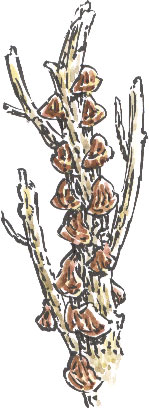
|
Ears to the GroundMonday, 16th December 2002, West Yorkshire |
![]()
![]()
![]()
![]() Rocks |
History |
Workshop |
Links |
Home Page
Rocks |
History |
Workshop |
Links |
Home Page
![]()
 After
three days of what has seemed like continuous rain streams are running
high and brownish with silt. The river is rising, rushing over the weir.
After
three days of what has seemed like continuous rain streams are running
high and brownish with silt. The river is rising, rushing over the weir.
This elder bush in the corner of a garden along the road is losing the battle to live. It's getting to the stage where you see more of the ear fungus growing on it that you do of the bark beneath.
During dry periods the 'ears' - spore-producing bodies of the fungus - appear to shrivel up, so much so that I think 'this time they're not going to be able to recover'. The rain and damp atmosphere have revived them, bringing back their fleshy, rubbery appearance.
Unlike human ears, these point down towards the ground - presumably to give the developing spores protection from the sun and rain as they develop and to allow them to drop out when ripe.
The bush seems already half-way to being recycled. Elders are so short-lived
that in the method for dating hedges devised by Dr Max Hooper you don't
count the species amongst the other woody plants of the hedge you're surveying.
Where other woody species seem to colonise a length of hedge at the rate
of about one species a century the elder just seems to drift in and out
of the hedgerow community in a random fashion.![]()
![]()
Richard Bell,
wildlife illustrator
E-mail; 'richard@willowisland.co.uk'
![]() Next page |
Previous page | This
day in 1999 | This
month | Nature
Diary | Home
Page
Next page |
Previous page | This
day in 1999 | This
month | Nature
Diary | Home
Page
![]()